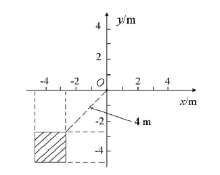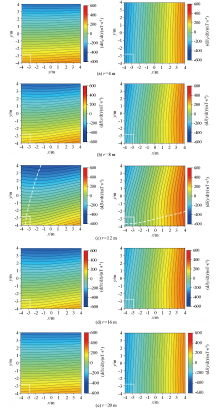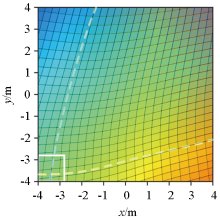|
|
|
| Seismic prediction of unfavorable geobodies in tunnels using the borehole-roadway transient electromagnetic method |
LI He1,2,3( ), LI Xiu4, QI Zhi-Peng4, CAO Hua-Ke4 ), LI Xiu4, QI Zhi-Peng4, CAO Hua-Ke4 |
1. Key Laboratory of Intelligent Detection and Equipment for Underground Space of Beijing-Tianjin-Hebei Urban Agglomeration, Ministry of Natural Resources, Shijiazhuang 050031, China
2. Hebei Key Laboratory of Strategic Critical Mineral Resources, Hebei GEO University, Shijiazhuang 050031, China
3. College of Earth Sciences, Hebei GEO University, Shijiazhuang 050031, China
4. School of Geological Engineering and Geomatics, Chang'an University, Xi'an 710054, China |
|
|
|
|
Abstract Tunnel detection in complex environments requires fine-scale detection of small unfavorable geobodies like karst caves and fissures. Hence, this study designed a tunnel construction model with a small karst cave in front of the tunnel face. A borehole was drilled at the center point of the tunnel face towards the construction direction, and then an electrical source was put into the borehole for excitation. Array data acquisition was conducted on the tunnel face. The 3D forward modeling based on transient electromagnetic data was performed using the time-domain finite element method. As indicated by the results, the electromagnetic sounding of the target was achieved through the movement of the electrical source, and the planar position of the unfavorable geobody was determined based on the distribution patterns of the electromagnetic field on the tunnel face. Therefore, electrical source excitation in a borehole can enhance the detection ability of the transient electromagnetic method on small karst caves, serving as a feasible method for improving the accuracy of tunnel seismic prediction.
|
|
Received: 23 June 2023
Published: 21 October 2024
|
|
|
|
|
|

|
Unstructured tetrahedral mesh
|

|
Schematic diagram of tunnel and karst cave model 1
|

|
The excitation source is located above the target body
|

|
Relative anomaly curves of electric and magnetic fields at measuring points (2,2,0)
|

|
Distribution of electric fields at different excitation positions on the tunnel face
|

|
Distribution of magnetic field at different excitation positions on the tunnel face
|

|
Distribution of magnetic field at different excitation positions on the tunnel face
|
Fig.6c
">

|
Overlay of dBx/dt and dBy/dt distributions in Fig.6c
|

|
Karst cave model 2
|

|
Distribution of dBx/dt and dBy/dt field at different excitation positions on the tunnel face
|
Fig.9c
">

|
Overlay of two cross-sections in Fig.9c
|
| [1] |
钱七虎, 李朝甫, 傅德明. 隧道掘进机在中国地下工程中应用现状及前景展望[J]. 地下空间, 2002(1):1-11,93.
|
| [1] |
Qian Q H, Li C F, Fu D M. The present and prospect of application of tunneler in China's underground engineering[J]. Underground Space, 2002(1):1-11,93.
|
| [2] |
李术才, 刘斌, 孙怀凤, 等. 隧道施工超前地质预报研究现状及发展趋势[J]. 岩石力学与工程学报, 2014, 33(6):1090-1113.
|
| [2] |
Li S C, Liu B, Sun H F, et al. State of art and trends of advanced geological prediction in tunnel construction[J]. Chinese Journal of Rock Mechanics and Engineering, 2014, 33(6):1090-1113.
|
| [3] |
Liu B, Fan K R, Nie L C, et al. Mapping water-abundant zones using transient electromagnetic and seismic methods when tunneling through fractured granite in the Qinling Mountains,China[J]. Geophysics, 2020, 85(4):B147-B159.
|
| [4] |
薛国强, 李貅. 瞬变电磁隧道超前预报成像技术[J]. 地球物理学报, 2008, 51(3):894-900.
|
| [4] |
Xue G Q, Li X. The technology of TEM tunnel prediction imaging[J]. Chinese Journal of Geophysics, 2008, 51(3):894-900.
|
| [5] |
Li S C, Zhou Z Q, Li L P, et al. Risk assessment of water inrush in Karst tunnels based on attribute synthetic evaluation system[J]. Tunnelling and Underground Space Technology, 2013,38:50-58.
|
| [6] |
Li X Z, Zhang P X, He Z C, et al. Identification of geological structure which induced heavy water and mud inrush in tunnel excavation:A case study on Lingjiaotunnel[J]. Tunnelling and Underground Space Technology, 2017,69:203-208.
|
| [7] |
李貅, 武军杰, 曹大明, 等. 一种隧道水体不良地质体超前地质预报方法——瞬变电磁法[J]. 工程勘察, 2006, 34(3):70-75.
|
| [7] |
Li X, Wu J J, Cao D M, et al. Advanced geologic forecasting for unfavorable geological body with water—Transient electromagnetic method[J]. Journal of Geotechnical Investigation & Surveying, 2006, 34(3):70-75.
|
| [8] |
薛国强, 潘冬明, 于景邨. 煤矿采空区地球物理探测应用综述[J]. 地球物理学进展, 2018, 33(5):2187-2192.
|
| [8] |
Xue G Q, Pan D M, Yu J C. Review the applications of geophysical methods for mapping coal-mine voids[J]. Progress in Geophysics, 2018, 33(5):2187-2192.
|
| [9] |
Xue G Q, Chen W, Cheng J L, et al. A review of electrical and electromagnetic methods for coal mine exploration in China[J]. IEEE Access, 2019,7:177332-177341.
|
| [10] |
Hwang J H, Lu C C. A semi-analytical method for analyzing the tunnel water inflow[J]. Tunnelling and Underground Space Technology, 2007, 22(1):39-46.
|
| [11] |
Home L. Hard rock TBM tunneling in challenging ground:Developments and lessons learned from the field[J]. Tunnelling and Underground Space Technology, 2016,57:27-32.
|
| [12] |
Bayati M, KhademiHamidi J. A case study on TBM tunnelling in fault zones and lessons learned from ground improvement[J]. Tunnelling and Underground Space Technology, 2017,63:162-170.
|
| [13] |
Dammyr Ø, Nilsen B, Gollegger J. Feasibility of tunnel boring through weakness zones in deep Norwegian subsea tunnels[J]. Tunnelling and Underground Space Technology, 2017,69:133-146.
|
| [14] |
Dammyr Ø. Prediction of brittle failure for TBM tunnels in anisotropic rock:A case study from northern Norway[J]. Rock Mechanics and Rock Engineering, 2016, 49(6):2131-2153.
|
| [15] |
Xue G Q, Yan Y J, Li X, et al. Transient electromagnetic S-inversion in tunnel prediction[J]. Geophysical Research Letters, 2007, 34(18):L18403.
|
| [16] |
程久龙, 陈丁, 薛国强, 等. 矿井瞬变电磁法超前探测合成孔径成像研究[J]. 地球物理学报, 2016, 59(2):731-738.
|
| [16] |
Cheng J L, Chen D, Xue G Q, et al. Synthetic aperture imaging in advanced detection of roadway using the mine transient electromagnetic method[J]. Chinese Journal of Geophysics, 2016, 59(2):731-738.
|
| [17] |
Cheng J L, Li F, Peng S P, et al. Joint inversion of TEM and DC in roadway advanced detection based on particle swarm optimization[J]. Journal of Applied Geophysics, 2015,123:30-35.
|
| [18] |
卢云飞, 薛国强, 邱卫忠, 等. SOTEM研究及其在煤田采空区中的应用[J]. 物探与化探, 2017, 41(2):354-359.
|
| [18] |
Lu Y F, Xue G Q, Qiu W Z, et al. The research on SOTEM and its application in mined-out area of coal mine[J]. Geophysical and Geochemical Exploration, 2017, 41(2):354-359.
|
| [19] |
齐彦福, 李貅, 殷长春, 等. 时间域航空电磁各向异性大地三维自适应有限元正演研究[J]. 地球物理学报, 2020, 63(6):2434-2448.
|
| [19] |
Qi Y F, Li X, Yin C C, et al. Three-dimensional adaptive finite-element method for time-domain airborne EM over an anisotropic earth[J]. Chinese Journal of Geophysics, 2020, 63(6):2434-2448.
|
| [20] |
Li H, Qi Z P, Li X, et al. Numerical modelling analysis of multi-source semi-airborne TEM systems using a TFEM[J]. Journal of Geophysics and Engineering, 2020, 17(3):399-410.
|
| [21] |
孙怀凤, 李貅, 李术才, 等. 考虑关断时间的回线源激发TEM三维时域有限差分正演[J]. 地球物理学报, 2013, 56(3):1049-1064.
|
| [21] |
Sun H F, Li X, Li S C, et al. Three-dimensional FDTD modeling of TEM excited by a loop source considering ramp time[J]. Chinese Journal of Geophysics, 2013, 56(3):1049-1064.
|
| [22] |
Li W H, Li H, Lu K L, et al. Multi-scale target detection for underground spaces with transient electromagnetics based on differential pulse scanning[J]. Journal of Environmental and Engineering Geophysics, 2019, 24(4):593-607.
|
| [23] |
Li H, Li X, Li W H, et al. An advanced detection method for unfavorable geological boulder based on electrical source in drill holes under shield machine[J]. Journal of Geophysics and Engineering, 2023, 20(2):426-438.
|
| [1] |
ZHU Xiao-Wei, DING Chen, XUE Kai-Xi, CHEN Jun, HAN Kai-Min, LUO Qiang, YI Guang-Sheng. Application of the opposing coils transient electromagnetic method in a shallow groundwater-rich area: A case study of Xiacun Town, Xinyu City[J]. Geophysical and Geochemical Exploration, 2024, 48(5): 1424-1436. |
| [2] |
LI Hai, ZHAO Pan, LI Ke-Ying, LIU Zheng. Deriving analytical solution of the pseudo wavefield from transient electromagnetic data[J]. Geophysical and Geochemical Exploration, 2024, 48(5): 1193-1198. |
|
|
|
|

